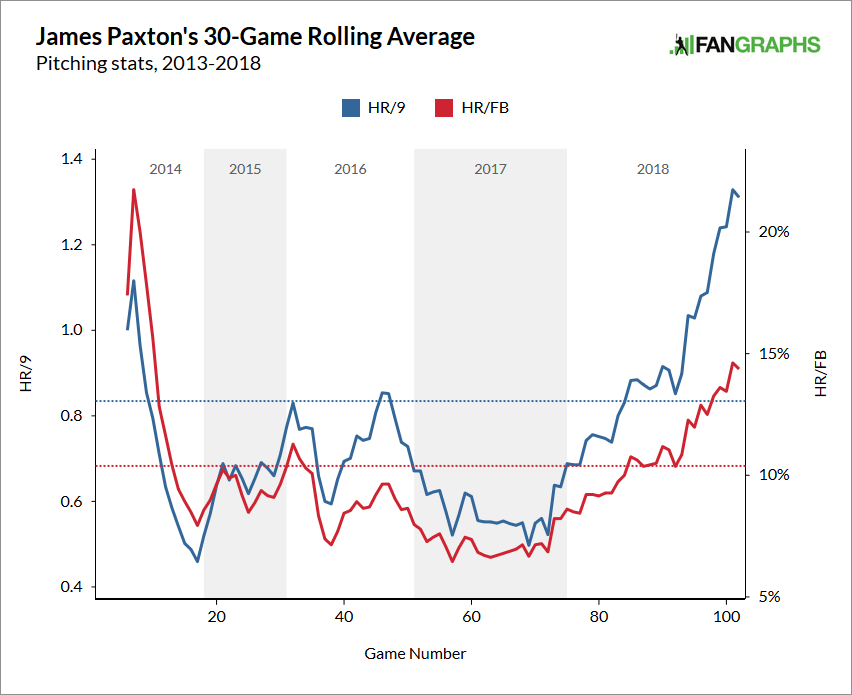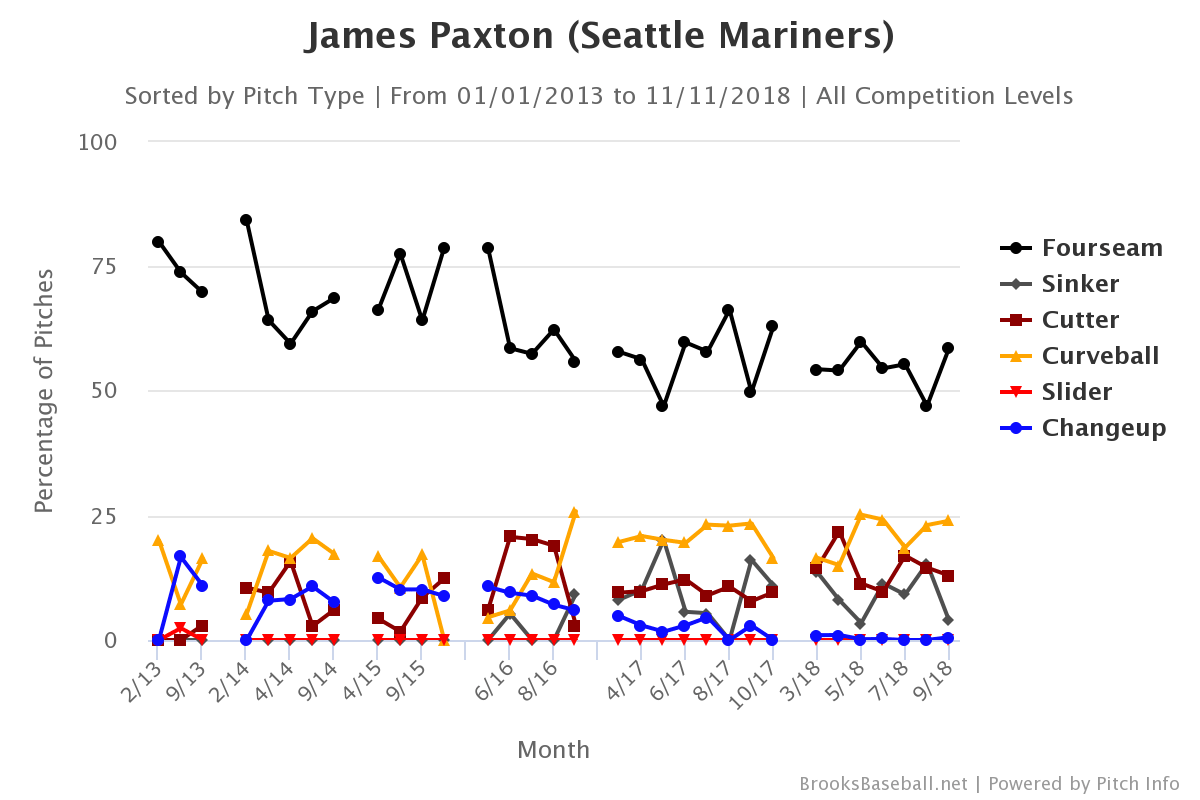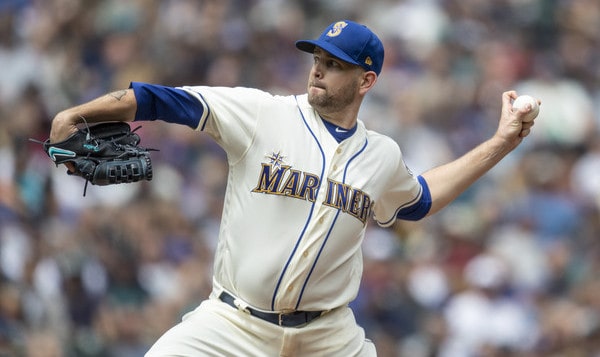
Baseball’s finances are broken. Despite record high revenue revenues, three large market teams (Cubs, Dodgers, Yankees) are reportedly going to limit their spending to some degree this offseason — the Cubs had to trade Drew Smyly and his $7M salary to pick up Cole Hamels’ option — and a three-time division winner (Indians) is said to be open to trading veterans to get their payroll in order. Teams that should be spending aren’t.
Furthermore, the Seattle Mariners, a team that appears capable of competing for a Wild Card spot next year, is embarking on a rebuild. They have the longest active postseason drought in North American sports — they haven’t been to the playoffs since Ichiro’s rookie year in 2001 — and, rather than make a push to win while Robinson Cano and other well-paid veterans are still productive, the Mariners are going to rebuild.
“We’re open-minded to different ways we can get better,” said GM Jerry Dipoto to Greg Johns and Maria Guardado at the GM Meetings when asked about a rebuild. “But what we’re hoping to achieve is to re-imagine our roster to look at it in terms of what is our quickest path to a championship club … If that means in 2019 we field as competitive a team as we can while earmarking and gathering talent, we’re not looking to rip our club down.”
The rebuild — sorry, the “re-imagining” — started last week when Seattle shipped Mike Zunino to the Rays for Mallex Smith. Zunino is a very flawed hitter, no doubt, but he’s a quality defender and a solid player at a hard-to-fill position. Trading two years of Zunino for four of Smith is not a move a team trying to contend next year would make. It is much easier to find an outfielder like Mallex Smith in free agency than it is a catcher like Mike Zunino.
Anyway, with the roster transition underway in Seattle, reports indicate the next Mariner on the move could be left-hander James Paxton. The pitching-needy Yankees have interest in Paxton and, according to Ken Rosenthal, they’ve already discussed him with the Mariners. Other teams are in the mix too, of course, including the Astros. Does Paxton make sense for the Yankees? Well, of course, but how much sense? Let’s dig in.
Background
Paxton is a 6-foot-4 southpaw who took an interesting path to the big leagues. He grew up in Vancouver and played his college ball at the University of Kentucky. The Blue Jays selected Paxton with the 37th overall pick in the 2009 draft — that was the compensation pick they received for the Yankees signing A.J. Burnett — but were unable to get him to agree to a contract prior to the signing deadline.
The NCAA declared Paxton ineligible for his senior year at Kentucky because he used an agent (Scott Boras) to negotiate on his behalf with Toronto, so he spent the spring of 2010 with the independent Grand Prairie AirHogs in Texas. The Mariners selected him in the fourth round of the 2010 draft and he started his climb up the minor league ladder. Paxton, who turned 30 last week, owns a career 3.42 ERA (3.13 FIP) in 582.1 big league innings.
Performance
After making his MLB debut in September 2013, Paxton went up-and-down a bit and battled injuries the next two seasons. It wasn’t until 2016 that he really established himself as a legitimate big league starter, with these last two years cementing him as an above-average pitcher. He’s not in the Chris Sale/Clayton Kershaw class of lefties, but he is quite good. Here are Paxton’s last three seasons:
| IP | ERA | FIP | K% | BB% | GB% | HR/9 | RHB wOBA | LHB wOBA | |
|---|---|---|---|---|---|---|---|---|---|
| 2016 | 121 | 3.79 | 2.80 | 22.9 | 4.7 | 48.1 | 0.67 | .303 | .319 |
| 2017 | 136 | 2.98 | 2.61 | 28.3 | 6.7 | 44.9 | 0.60 | .273 | .210 |
| 2018 | 160.1 | 3.76 | 3.24 | 32.3 | 6.5 | 39.6 | 1.29 | .268 | .377 |
Paxton has traded some ground balls for strikeouts — that seems to be a very common trend throughout baseball as pitchers emphasize strikeouts and hitters emphasize getting the ball airborne — and this year there was a huge uptick in home runs. Prior to this season Paxton was a steady 0.60-ish HR/9 guy with an 8%-ish HR/FB rate. This year those numbers basically doubled. A graph:

You can partially blame the Yankees for the uptick in homers. They faced Paxton twice this past season and took him deep four times in eleven innings. Would’ve been five had Mitch Haniger not robbed Giancarlo Stanton of a homer. In all seriousness, that’s a large increase in home runs. The jump in HR/FB rate indicates it’s not as simple as “more fly balls equal more homers” either. The fly balls were leaving the yard more often.
The numbers against left-handed batters this season appear to be straight sample size noise. Paxton faced only 112 lefties in 2018 — that was roughly 20% of all batters he faced — and only 63 of those 112 lefties put the ball in play. Those 63 balls in play produced a .492 (!) BABIP despite a hard contact rate in line with his career norms. Paxton’s expected wOBA against lefties from 2016-18: .315, .242, .265. Compare that to the actual wOBAs in the table above.
Paxton’s home run problem did include lefties — he allowed three homers to those 112 lefty batters this season after allowing three homers to the 308 lefties he faced from 2013-17 — but again, it’s a small sample. I am okay with chalking up this year’s issues with same-side hitters to sample size weirdness. Sixty-three balls in play and a .492 BABIP? Come on. The overall home run issue is another matter. That I wouldn’t be so quick to brush aside.
Current Stuff
In this era of declining fastball usage — the Yankees have taken it to the extreme with their anti-fastball philosophy, but, generally speaking, fastball usage has declined around the league — Paxton is a throwback. He throws his mid-90s four-seamer roughly 60% of the time and his 88-90 mph cutter around 20% of the time, so that’s approximately 80% fastballs. A low-80s curveball is his breaking ball. Here’s his pitch selection over the years:

Paxton has more or less shelved his slider and changeup and hey, it’s working for him. Oddly enough, he uses the cutter more against lefties than righties. Going into this I assumed he used the cutter to pitch righties inside a la CC Sabathia, but nope. I mean, he does do that, but he generally attacks righties with the four-seamer and curveball. Lefties — the few lefties he faces — get the four-seamer, cutter, and curveball. Huh.
On the spin rate front, Paxton is roughly league average with his four-seamer (2,283 rpm vs. 2,263 rpm average) whereas his curveball is comfortably below average. His curveball had a 1,949 rpm average spin rate in 2018. The MLB average was 2,493 rpm. Despite that, Paxton’s curveball had a comfortably above-average 39.9% whiffs-per-swing rate (MLB average is 32.0%) because he sets it up well with elevated fastballs. Check it out:
James Paxton, 96mph Fastball and 82mph Knuckle Curve, Overlay. pic.twitter.com/WcxyIl3pep
— Rob Friedman (@PitchingNinja) August 10, 2018
Ask hitters and they’ll tell you the easiest curveballs to hit are the ones with a hump, meaning curveballs that come out of the pitcher’s hand and rise up a bit before breaking down. There’s no hump in Paxton’s curveball. It comes out on the same plane as his fastball. The hitter reads fastball, his brain tells his arms to start swinging at the fastball, and then the curveball breaks down below the zone. It is brutally effective when executed properly.
In what was undoubtedly the best two-start stretch by any pitcher in 2018, Paxton struck out 16 Athletics on May 2nd and no-hit the Blue Jays on May 9th. No one has made a “James Paxton 2018 highlights” video yet, so here’s every out of the no-hitter, which best shows his full arsenal at work (here’s the 16-strikeout video, if you’re interested).
- Lance Lynn: 88.9%
- James Paxton: 81.5%
- David Price: 74.9%
- Jon Lester: 74.8%
- J.A. Happ: 73.3%
The anti-fastball Yankees traded for two of those five pitchers this past season and now they’re interested in acquiring another. I reckon the Lynn and Happ pickups had more to do with the market than their pitching style — you can only acquire guys who are available and they were available — but the important thing is the Yankees let them be. They let them continue throwing heaters. They didn’t force the anti-philosophy on them.
Paxton does not appear to be a good fit for the anti-fastball lifestyle. His best pitch is the four-seam fastball and his curveball is a good pitch, but not a truly dominant pitch. Paxton’s success stems from his fastball and having him scale back on that pitch doesn’t seem like a good idea. That doesn’t disqualify him as a Yankees’ trade target though. Lynn and Happ showed the Yankees are flexible. Not everyone has to get the organizational stamp.
Injury History
Those 160.1 innings Paxton threw this season are almost a career high. He threw 171.2 innings in 2016 and 169.2 innings back in 2013. Paxton has landed on the disabled list at least once each year from 2014-18. The injury list:
- 2014: Missed four months with a lat strain.
- 2015: Missed close to four months with a strained tendon in his left middle finger.
- 2016: Missed two weeks after taking a line drive to the pitching elbow.
- 2017: Missed a month with a forearm strain and another month with a strained pectoral.
- 2018: Missed three weeks with back inflammation and two weeks after taking a line drive to his left forearm.
I suppose the good news is Paxton’s elbow and shoulder are structurally sound. He did miss a month with a forearm strain last year and forearm strains are a common precursor to elbow trouble and Tommy John surgery, but Paxton returned from that injury and has had no other elbow/forearm trouble since. Well, no other trouble aside from the comebacker this season, which is just bad luck.
The best predictor of future injury is past injury and there are enough muscle strains and whatnot here to suggest Paxton might never be a 200-inning guy. That’s okay. There is a ton of value in being an above-average starter for 160-170 innings. We’d all love 200-inning guys but they are becoming increasingly hard to find. Teams are focused more on quality innings rather than quantity of innings, and Paxton can provide quality.
Contract Status
Paxton has four years and 151 days of service time (written as 4.151), which means two things. One, he has two years of control remaining before free agency. And two, this offseason he is arbitration-eligible for the third time as a Super Two. MLBTR projects a $9M salary in 2019. That likely puts his 2020 salary in the $15M range. Below-market salaries, no doubt, but not super duper cheap either.
Also, for what it’s worth, Paxton has two minor league options remaining. Those are valueless though. For starters, if you have to think about sending him to Triple-A at some point, something’s gone horribly wrong. You’re not trading for this guy to be an up-and-down depth arm, you know? And secondly, 21 more days of service time gets Paxton to five full years and gives him the right to refuse an assignment to the minors.
What’s It Going To Cost?

The million dollar question. There have been surprising few starters traded with two years of control in recent years. I’ve found three and, honestly, only one seems instructive for Paxton. The three:
- Gerrit Cole: Traded for an MLB swingman (Joe Musgrove), an MLB middle reliever (Michael Feliz), and two organizational top 20 prospects (Colin Moran, Jason Martin).
- Doug Fister: Traded for a global top 90-100 prospect (Robbie Ray) and two MLB role players (Ian Krol, Steve Lombardozzi).
- Jake Odorizzi: Traded for an organizational non-top 30 prospect (Jermaine Palacios).
The Odorizzi trade was very clearly a salary dump. That doesn’t help us at all. The Tigers were widely ripped for getting such a light package for Fister, though Ray has worked out after being flipped to the Diamondbacks in the Didi Gregorius three-team trade. At the time though, it was an underwhelming package for a quality pitcher. The same is true with Cole. That four-player package seemed awfully light at the time and it looks even worse now.
Maybe the Fister and Cole trades indicate the price to get Paxton will be lower than expected? Paxton is at +10.9 WAR and 582.1 career innings right now. Fister was at +14.2 WAR in 818.2 innings at the time of his trade and Cole was at +11.5 WAR in 782.1 innings. The Mariners would understandably ask for a top prospect or quality young MLB player to lead a Paxton trade package. That’s what I’d want. Perhaps the Cole trade is enough of a precedent to come back with a quantity over quality counteroffer? I get the sense a bidding war will make a Cole package unlikely.
Does He Make Sense For The Yankees?
For sure. And, to be honest, I’m more on board with Paxton as a trade target now than I was before writing this post. The injury history isn’t as scary as I thought — for some reason I thought he had more elbow and shoulder problems — and I am forever down with starters who can get swings and misses with their fastball in the strike zone. Paxton doesn’t have an extreme platoon split and quality lefties are always a good mix with Yankee Stadium.
I have two concerns with Paxton. One, what’s up with that home run spike? That happened while he pitched his home games in Safeco Field. What happens with a move into Yankee Stadium? And two, I do worry there is some Michael Pineda in Paxton, meaning sexy peripherals but more hittable than the stuff would lead you to believe because he’s around the middle of the plate so much. Lots of strikeouts, few walks, and an ERA consistently higher than his FIP. Pineda and Paxton have that in common.
The Yanks are looking to add two more starters even after re-signing Sabathia and Paxton will probably be the best starter to hit the trade market this winter. If I had to pick one, I would prefer signing Patrick Corbin for just money over trading prospects for Paxton. This is not an either/or though. The Yankees could do both, sign Corbin and trade for Paxton, at least in theory. I don’t buy Paxton as an ace. He’s an above-average starter though, and he would undoubtedly make the Yankees a better team.